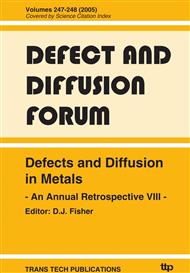[1]
G.G. Harman. The Ultrasonic Welding Mechanism as Applied to Aluminum- and Gold-Wire Bonding in Microelectronics. IEEE Transactions on Packaging, 1997, 13.
DOI: 10.1109/tphp.1977.1135225
Google Scholar
[2]
Li Jun-Hui, Han Lei, and Zhong Jue. Microstructure Characteristics at the Thermosonic Bond Interface. China Mechanical Engineering, 2005, 16.
Google Scholar
[3]
Vern H., Winchell I., and Howard B., Enhancing Ultrasonic Bond Development. IEEE Transactions on Manufacturing Technology, 1998, 1.
Google Scholar
[4]
Jiromaru Tsujino, Hiroyuki Yoshihara, Tsutomu Sano et al. High-Frequency Ultrasonic Wire Bonding Systems, Ultrasonics, 2000, 38.
DOI: 10.1016/s0041-624x(99)00173-0
Google Scholar
[5]
Jiromaru Tsujino, Hiroyuki Yoshihara, Kazuyoshi Kamimoto, et al., Welding Characteristics and Temperature Rise of High-Frequency and Complex Vibration Ultrasonic Wire Bonding, Ultrasonics, 2002, 36.
DOI: 10.1016/s0041-624x(97)00075-9
Google Scholar
[6]
Shivesh Suman, Yogendra Joshi, G.G. Harman et al., Wire Bond Temperature Sensor. National Institute of Standards and Technology, 2002, 1, 5-14.
Google Scholar
[7]
M. Mayer, O. Paul, D. Bolliger et al., Integrated Temperature Microsensors for Characterization and Optimization of Thermosonic Ball Bonding Process, Proceedings of the 1999 Electronic Components and Technology (ECTC), San Diego, California, 1999, 463-8.
DOI: 10.1109/ectc.1999.776216
Google Scholar
[8]
S.Y. Kang, P.M. Williams, Y.C. Lee, Modeling and Experimental Studies on Thermosonic Flip Chip Bonding, IEEE Trans. on Components, Packaging, and Manufacturing Technology, 1995, 18.
DOI: 10.1109/96.475282
Google Scholar
[9]
Peter Elenius and Lee Levine, Comparing Flip-Chip and Wire-Bond Interconnection Technologies, IEEE Transactions on Packaging, 2000, 8, 81-7.
Google Scholar
[10]
Qing Tan, Brian Schaible, Leonard J. et al., Thermosonic Flip Chip with a Self-Planarization Feature Using Polymer, IEEE Trans. on Components, Packaging, and Manufacturing Technology, 1998, 19.
DOI: 10.1109/ectc.1998.678915
Google Scholar


